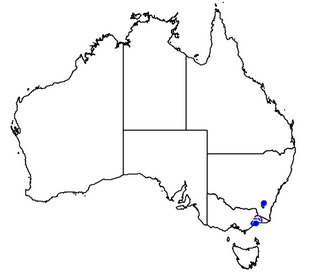Acacia caerulescens
| Acacia caerulescens |
|
|---|---|
Contents
General Plant Info
Acacia caerulescens, also know as "Buchan Blue Wattle" or "Limestone Blue Wattle", is a small evergreen tree, up to 12m high, 6m wide, which has pyramidal shape. The bark on young trees is smooth but becomes dark and fissured as the tree ages. It has blue green phyllodes and attractive pale-yellow flowers. The fruit is an oblong pod.
It occurs in a range of vegetation types varying from shrubland to the edges of warm temperate rainforest. All areas have the common characteristic of underlying limestone geology.
It is listed as a threatened species (Flora and Fauna Guarantee Act 1988 (Victoria): February 2014).
In the past, it was certainly more widespread and abundant within the region where it currently occurs, but populations have been fragmented and depleted historically by land clearance for settlement and agriculture. It is estimated that only approximately 1700 individuals exist within 15 wild populations. Threats include weed invasion, road works, land clearing and grazing. A recovery plan has been prepared.
This species is closely related to Acacia obliquinervia ("Mountain Hickory Wattle"). The phyllodes of Mountain Hickory Wattle, however, are less glaucous and often longer, and the gland is 0-12 mm above the pulvinus. Acacia obliquinervia also lacks an associated fine, oblique vein extending to the pulvinus, and has bright yellow flower heads. Furthermore, it has much smaller secondary branching and different bark.
Acacia obliquinervia is restricted to limestone soils whereas Acacia obliquinervia is never found on limestone,
Geographic distribution
This species is native to a small area in the Gippsland region of Victoria, Australia.
Identification
Tree to 10–15 m high, often pyramidal in outline. Branchlets pruinose, glabrous.
Phyllodes obovate to oblanceolate or elliptic to narrowly elliptic, 4–8 cm long, 1.5–3 cm wide, narrowed and often shallowly recurved near base, obtuse, glaucous, pruinose when young, glabrous, with midrib central or towards the adaxial margin, finely penninerved; gland 5–25 mm above the pulvinus, connected to pulvinus by a fine, oblique nerve.
Inflorescences racemose but racemes often in panicles 4–9 cm long; raceme axes 1–3 cm long, glabrous; peduncles 6–8 mm long, rather slender, glabrous; heads globular, mostly 20–30-flowered, lemon yellow. Flowers 5-merous; sepals united.
Pods stipitate, 5–12 cm long, 14–22 mm wide, chartaceous, pruinose, glabrous.
Seeds longitudinal to longitudinally oblique, elliptic, 5–6 mm long, dull, black; funicle thick, red-brown, constricted at junction with aril.
Alkaloid content
Other uses
There is no recorded history of it's use by humans.
Extraction
Cultivation
Suppliers
Links
http://www.environment.gov.au/cgi-bin/sprat/public/publicspecies.pl?taxon_id=21883
http://www.worldwidewattle.com/speciesgallery/caerulescens.php
http://www.dse.vic.gov.au/__data/assets/pdf_file/0008/103301/222_Limestone_Blue_Wattle_2008.pdf

